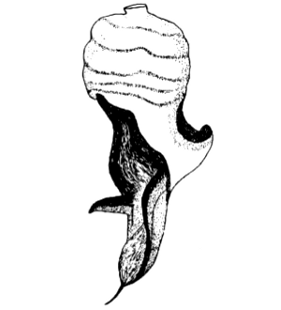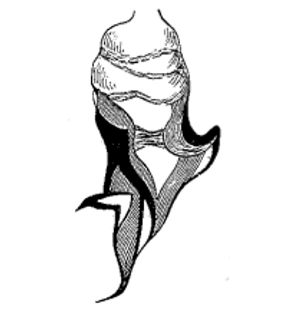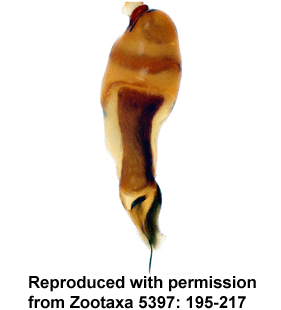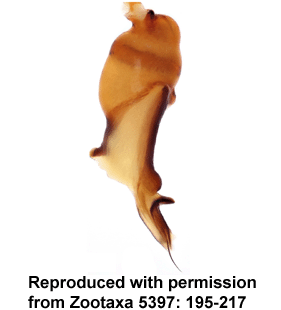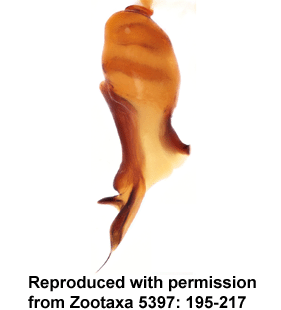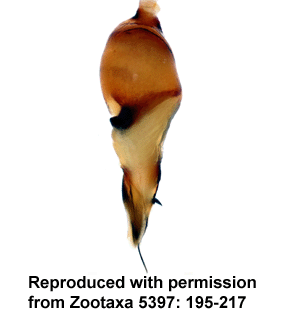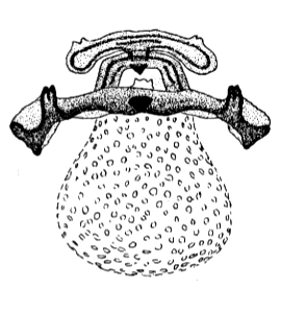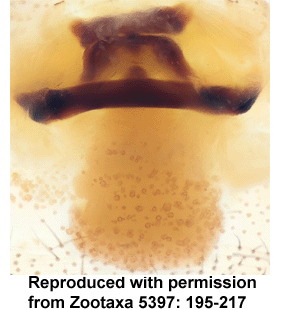Dysdera concinna L. Koch, 1878
Description
Male
Carapace length 5.1 mm, width 4.2 mm, width of cephalic part 2.2 mm. Carapace surface dull carmine-brown, finely shagreen and with a poorly developed longitudinal furrow. Length of the basal chelicere segment 2.8 mm, the same color as the carapace. Sternum, labium, and coxae lighter than carapace, ranging from red-brown (labium, gnathocoxa) to orange-red (coxa IV). Leg color also ranges from red-brown (coxae, hips) to orange-red (metatarsi, tarsi). Legs I and II darker than III and IV. Pedipalps reddish brown. Ratio of anterior-eye diameter to their distance 17:14. Leg spination: coxa and patella are not armed, femur I with 2 closely standing apical antero-dorsal spines, femora II and III with 1 spine in this spot, femur IV in the basal half with 2.2.1.1.1 (or 2.2.2.1.1) dorsal spines. Tibia and metatarsus I and II unarmed, tibia III with 1.1 anterior, 1.1 posterior and up to 4 ventro-apical and lateral spines, tibia IV with 1 median dorsal spine, 1 anterior and postero-apical spine as well as to 4-5 ventral and lateral spines. Abdomen length 7.3 mm, width 3.25 mm, cylindrical, gray, but with a reddish tint near the front due to a cover of red and ginger setae.
Female
Carapace length 5.3 mm, width 4.15 mm, width of cephalic part 2.85 mm. Chelicere length 2.5 mm. Abdomen length 10.3-11.3, width 4.6 mm. Distance between the anterior eyes three-quarters of their diameter. Carapace dull carmine-brown and finely shagreen-like. Pits poorly developed, shallow and present on sides an cephalic part. Longitudinal furrow formed by pits on shallow cephalic part, aside from it with two poorly developed longitudinal ridges. Chelicerae colored like carapace, with fine granulation, which is more dense on the dorsal- lateral part and the medial side. Sternum reddish-orange, vermiculated, except the front, which is markedly wrinkled. Leg spination as in the male, but femur II with two closely standing apical antero-dorsal spines (rather than one as in the male). Abdomen with no signs of gray brown, red or blond. Hairs on the abdomen lighter and smaller.
D. concinna is significantly larger than D. aculeata (carapace length 5.1-5.4 mm vs. 4.5-5.0 mm). The diameter of the front eyes is larger than their distance in D. concinna but comparable in D. aculeata. Both species also differ in leg spination: D. concinna has no spines on coxae and patellae I-IV; femur I with less antero-apical spines (2.1-2.1.0 vs. 3.2-3.2-3.1) and femur IV with more dorsal spines in basal position (2.2.1.1.1 vs. 2.1.1). Male copulatory organs also differ.
Body length female: 16.5 mm
Additional information
In Hyrcan relict forests on the forest floor, under rocks, in tree trunks. In the mountains up to 1,200 meters above sea level.
Distribution
Phenology
| Jan | Feb | Mar | Apr | May | Jun | Jul | Aug | Sep | Oct | Nov | Dec |
 |  |
Figures
Distribution List
"No references" does not mean that the species does not occur in this country, but that we have not yet inserted the reference for it. We are working on it.
References
Deeleman-Reinhold C L, Deeleman P R (1988) Revision des Dysderinae (Araneae, Dysderidae), les espèces mediterranéennes occidentales exceptées. Tijdschrift voor Entomologie 131: 141-269 ![]()
Dunin P M (1982) New data on Dysdera concinna L. Koch (Aranei, Dysderidae). Zoologicheskiĭ Zhurnal 61: 605-607 ![]()
Dunin P M (1992b) The spider family Dysderidae of the Caucasian fauna (Arachnida Aranei Haplogynae). Arthropoda Selecta 1(3): 35-76 ![]()
Otto S (2022) Caucasian spiders. A faunistic database on the spiders of the Caucasus Ecoregion. Database version 02.2022. Internet: caucasus-spiders.info.
WSC (2025) World Spider Catalog. Version 26. Natural History Museum Bern, online at http://wsc.nmbe.ch (28.2.2025) doi: 10.24436/2 ![]()
Zamani A, Marusik Y M (2024) New data on Dysdera Latreille, 1804 and Harpactea Bristowe, 1939 (Araneae: Dysderidae) of the Caucasus, with new species and records. Zootaxa 5397: 195-217 ![]()
